|
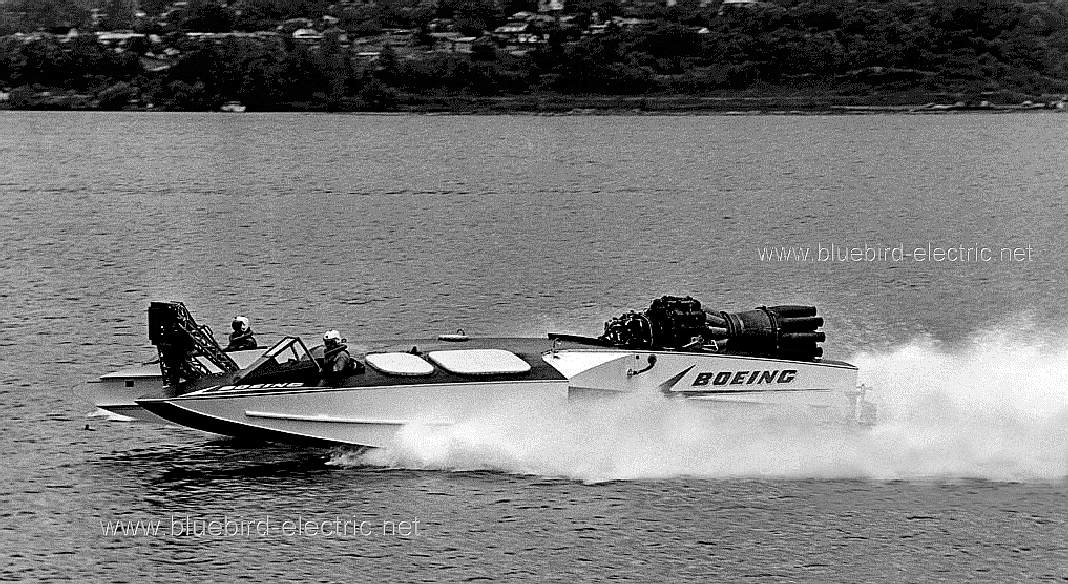
LAKE
WASHINGTON - The Boeing Aqua-Jet is seen here on Lake Washington, a jet engine powered experimental speed boat made by
the famous aircraft company, Seattle, Washington, early 1960s. It is 38 feet long with a 17 foot beam, can reach speeds of 100 knots (115 mph), and is powered by an Allison J-3 turbojet with 4600 pounds of thrust.
The Boeing Company is
associated with aircraft production. However, Boeing is also active in the production of missiles,
spacecraft, train systems and
boats. Boeing’s boats are in particular very interesting since they all were high-speed hydrofoil boats using Boeing’s aerospace technology.
Boeing eventually stopped development of new hydrofoil vessels, mainly
because they were not very economical under operational conditions, they are
though very interesting designs.

A
drawing of the Boeing AquaJet gas turbine powered three point hydroplane.
BOEING
HYDROFOIL DEVELOPMENT HISTORY
Aqua-Jet
(HST)
Boeing started from 1961 to 1966 experiments with a jet-powered catamaran . It was called the Aqua-Jet, but was also know as the HST (Hydrodynamic Test System) Between its ‘sponsons’ it had a continuous water tunnel for measuring of the hydrodynamic properties of a large number of hydrofoil profiles at different angels of attack and speed. It was powered by an Allison J-33 turbojet of 2087 kg thrust that gave it a maximum speed of more than 185 km/h. In 1963 the J-33 was replaced by a more powerful Pratt & Whitney J-48 turbojet of 2880 kg thrust. Top speed was increased to 215 km/h.
The Aqua-jet had a length of 11.58 m and a width of 5.16 m. Water displacement was six tons. Both sponsons had a single seat ‘cockpit’ in front.
The Aqua-Jet was operated on Lake Washington in Seattle in calm water conditions and during daylight and delivered invaluable data for basic knowledge of hydrofoil design for the next Boeing projects!
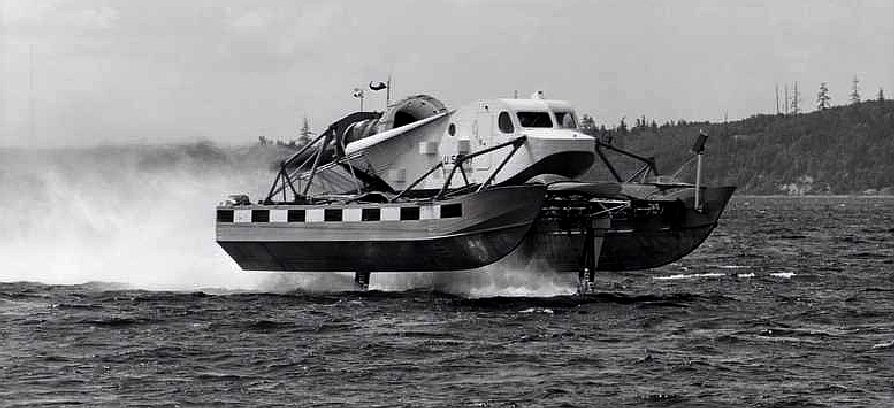
FRESH
1 - Not quite to fresh as the name implies, though one could argue
that any new boat design is a
fresh
project,
save for the knowledge and experience that one brings to the table from
previous boating forays.
Fresh-1
Based on the experiments with the Aqua-jet Boeing built in 1963 a larger jet-powered hydrofoil research vehicle under a U.S. Navy contract. It had a closed cabin and, just like its predecessor, catamaran-type sponsons. It had a weight of 16.7 tons and a length of 16.15 m.
It was intended to investigate various hydrofoil systems at very high speed and was capable to reach 160 km/h.
During a series of high speed test trials over the surface of the Puget Sound it capsized on 18 July 1963 at a speed of some 135 km/h. Pilot Vern Salisbury, co-pilot Pete Sias and Boeing employee Bob Hubbart could all three be recovered very quickly with only minor injuries. After the accident, the Fresh-1 was repaired and it successfully completed its acceptance trials for the Navy. The accident strongly influenced the US Navy’s decision to abandon its goal of a 100-knots hydrofoil and concentrated instead on achieving reliable 50 knots operations and all work to have a ‘100 knots’ operating hydrofoil boat was suspended. Fresh-1 was mothballed and never ran again!
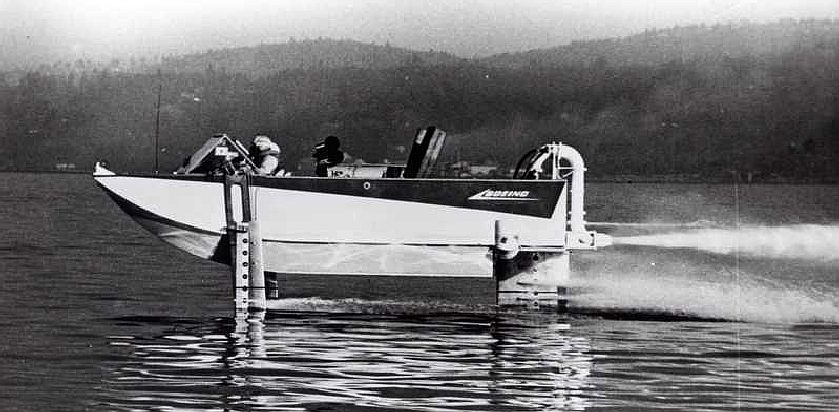
L ITTLE
SQUIRT - A water jet propelled hydrofoil seen
here on Lake Washington.
Little Squirt
To investigate water jet propulsion on hydrofoil crafts, Boeing tested in the early to mid sixties a small 6 m long hydrofoil vessel of 2.5 tons. It was powered by a centrifugal pump with a flow rate of 13,627 l/min. and had a W-form hull.
The small craft accumulated about 110 hours of foil-borne operation on Lake Washington and Puget Sound, sometimes operating in 3-foot (90 cm) waves. The craft achieved speeds of up to 45 knots and established the technical basis for proceeding to the water jet propulsion designs of Boeing’s later military and commercial hydrofoil crafts.
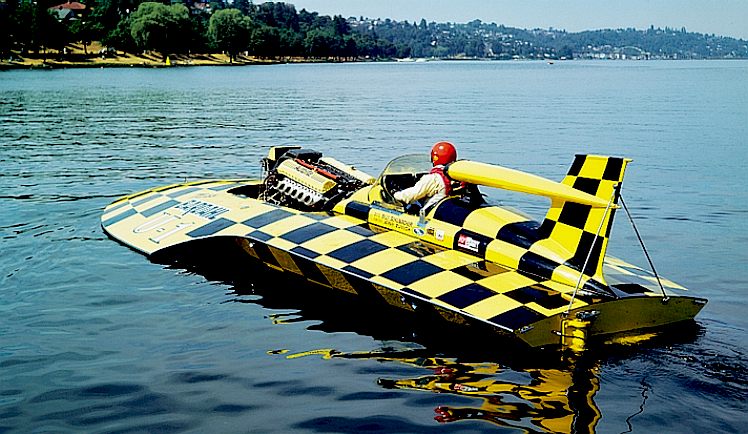
MISS
BARDAHL - This is the U1, three
times gold cup winner powered by a Rolls Royce V12 piston engine.
PCH-1 High Point
For operational evaluation by the U.S Navy Boeing built a hydrofoil vessel with designation PCH-1 where PCH stood for Patrol Craft Hydrofoil and named ‘High Point’ after the city in North Carolina.
For normal propulsion it used a General Motors 12V71 Diesel
engine; when it was ‘foilborne’ it used two Rolls Royce Proteus gas turbines to propel the shafts of the hydrofoils.
It had a water displacement of 110 tons and a length of 35.0 m. On full power it could reach a maximum speed of 48 knots, or 86.4 km/h. Normally it could cruise at more than 30
knots or 54 km/h. The craft was launched on 17 August 1962 and was placed into service one year later on 15 August 1963. High Point was used operationally by the U.S. Navy until March 1975. It was transferred to the U.S. Coastguard and used until 5 May 1975. In 1980 is was finally put out of use and returned to Boeing some years later. It made its final ‘flight’ on 11 May 1989. In 2002 it was purchased by a private owner for restoration, but this did not succeed. Terence Orme saved it in 2005 from scrap and volunteers are now restoring the craft as a future
museum piece.
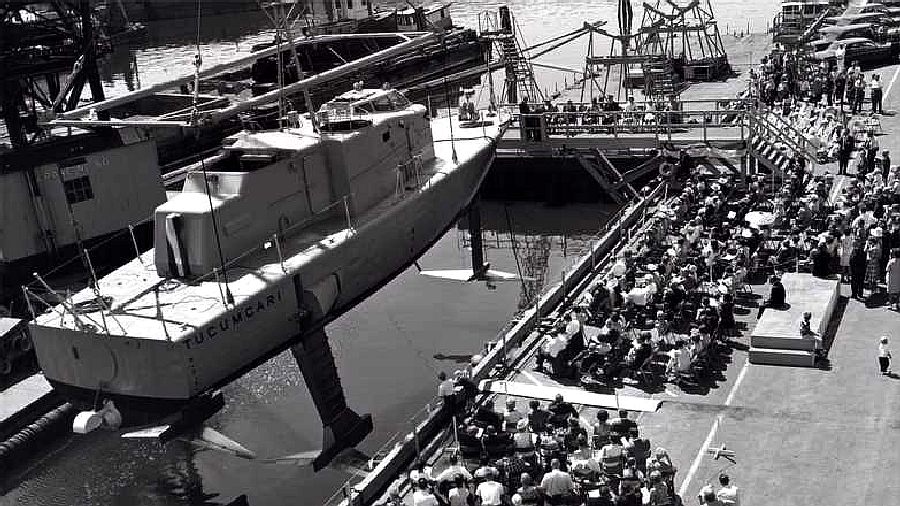
TUCUMCARI
- Finally the US Navy ordered the development of this fine hydrofoil boat,
seen here as it is being lowered into the water.
Tucumcari (PGH-2)
The next hydrofoil craft from Boeing was the PGH-1 where PGH stood for Patrol Gunboat Hydrofoil. The ‘-2’ means it was the second type built. Also Grumman was active in hydrofoil boat construction and PGH-1 ‘Flagstaff’ was in fact their product!
Boeing’s PGH-2 was named ‘Tucumcari’ after Tucumcari, New Mexico. It was a 57 ton armed patrol boat with a length of 21.95 m powered by a
Rolls Royce Proteus gas turbine driving water jets. Tucumcari was armed with one 40mm cannon, four .50 cal. machine guns and one 81 mm mortar. It had a crew of one officer and 12 enlisted men.
Tucumcari was launched on 15 July 1967 at Seattle, witnessed by some 500 guests. It was delivered to the U.S. Navy on 8 March 1968.
The PGH-2 was used from the Naval Amphibious Base Conorado for operational evaluation.
Later it was used during the Vietnam war for coastal patrol preventing infiltrations of Vietcong troops and material. The craft returned to the United States in 1970 and was used on the West Coast and later also on the East Coast. It made an extensive promotional tour visiting various European
NATO countries to gain interest for this type of ship. It returned later to the
US and was used until 19 November 1972 when it was damaged when it hit at high speed a
coral reef. It was extensively damaged and never fully repaired.
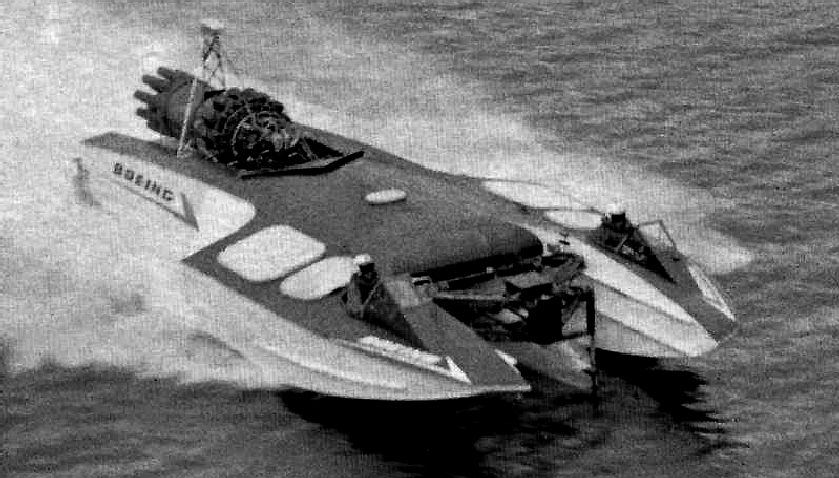
THE
JET AGE - This 1960s concept Boeing Aqua-Jet is truly a display of power (with its mounted airplane jet engine), featuring true aerodynamic shape.
This is a larger version of the Slo
Mo Shun and Miss
Bardahl racing boats.
PHM-1 Pegasus
After ‘Tucumcari’ had proven to be a fully capable warship, Boeing received in February 1973 a contract for the construction of an even larger
missile armed hydrofoil craft for the U.S. Navy. The ship was designated as PHM-1 (PHM meaning Patrol Hydrofoil Missile) and the first one was named Pegasus.
The construction was started on 18 May 1973 and launch took place on 9 November 1974.
Pegasus was a 255 ton vessel with a length of 41 m, powered by two Mercedes-Benz marine hullborne diesel engines of 1,600 hp each. For foilborne propulsion it had a General Electric LM2500 gas turbine of 18,000 shaft hp. Top speed when foilborne was almost 90 km/h. Under operational conditions it had a crew of 4 officers and 17 enlisted men. Armament was
2×4 launch tubes for the RGM-84 Harpoon missile, a rapid-firing 76 mm Mk.75 OTO Melara cannon and a .62 cal. machine gun.
They were stationed at Key West, Florida and used for a number of years for armed patrol missions. It was hoped that navies from other countries like
Canada, the UK and
Germany would also order the PHM for their fleet, but no orders were finally placed.
All crafts were retired in the early nineties. In general they were found to be not cost-effective for their naval patrol missions. Only PHM-5 Aries still exists as a monument at Grand River in Brunswick, Missouri. The other PHM’s were all
scrapped.
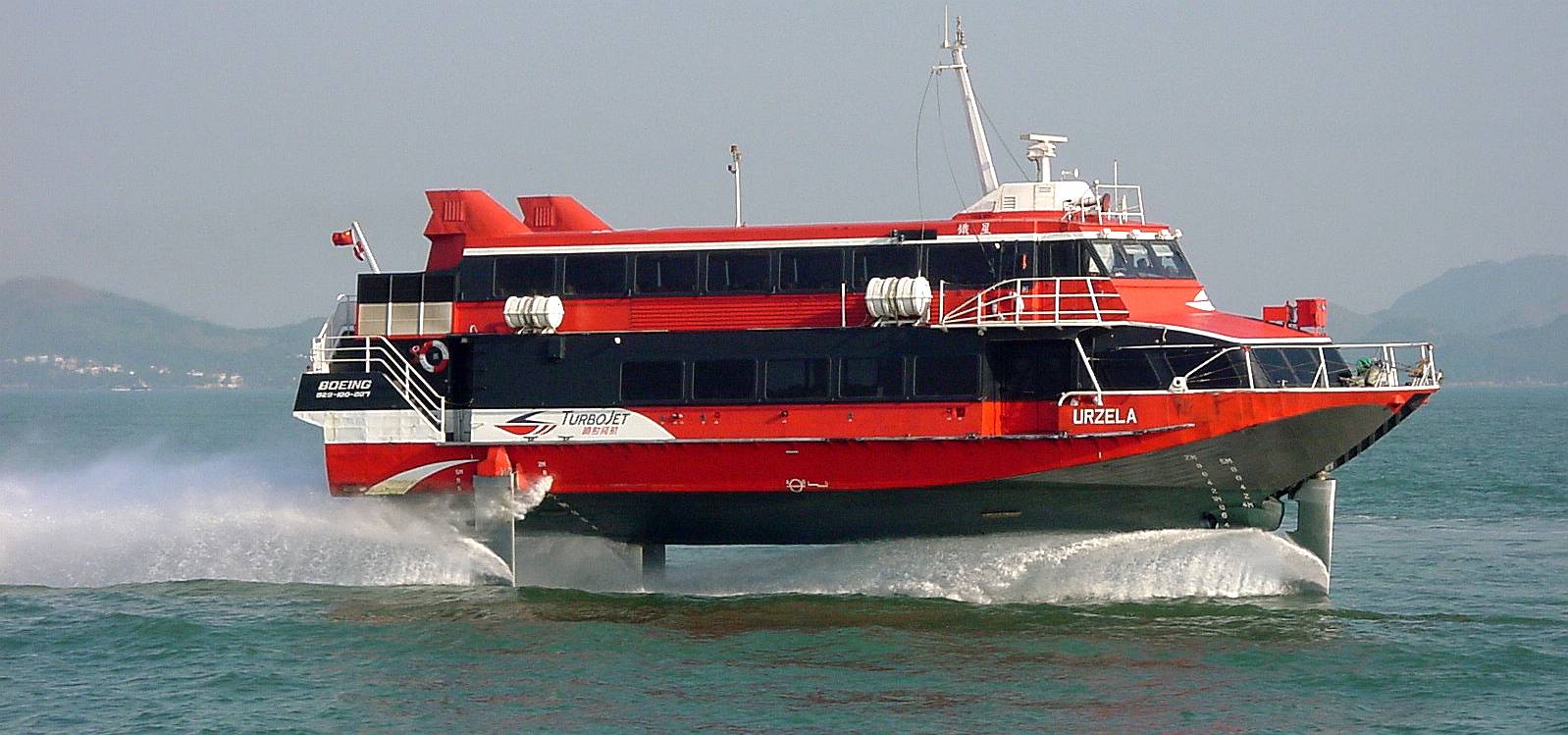
BOEING
929 JETFOIL - The Boeing 929 Jetfoil is the name for a passenger-carrying
waterjet-propelled hydrofoil design by Boeing.
Boeing began adapting many systems used in jet airplanes for hydrofoils. Robert Bateman led development. Boeing launched its first passenger-carrying
waterjet-propelled hydrofoil in April 1974. It could carry from 167 to 400 passengers. It was based on the same technology pioneered by the patrol hydrofoil Tucumcari, and used some of the same technology used in the Pegasus class military patrol hydrofoils. Currently this product line is sold to the Japanese company Kawasaki Heavy Industries.
The Jetfoil had a length of 27.5 m and was powered by two Allison 501-KF turbine engines with two Rocketdyne PJ-20 waterjet pumps. It had a capacity of 250 to 350 passengers with a crew of 4 to 8. The first launch of the Jetfoil took place on 29 March 1974, Boeing built in total 20 civil Jetfoils for various shipping companies all over the world.
They also sold in 1979 one Jetfoil for military evaluation by the Royal Navy. It was christened as HMS ‘Speedy’ after one of their historic battleships. Speedy was used to gain operational experience of the hydrofoil craft; in particular for patrol missions of the Fishery Protection Squadron. Of course, the Speedy was adapted for military duties rather than for transport.
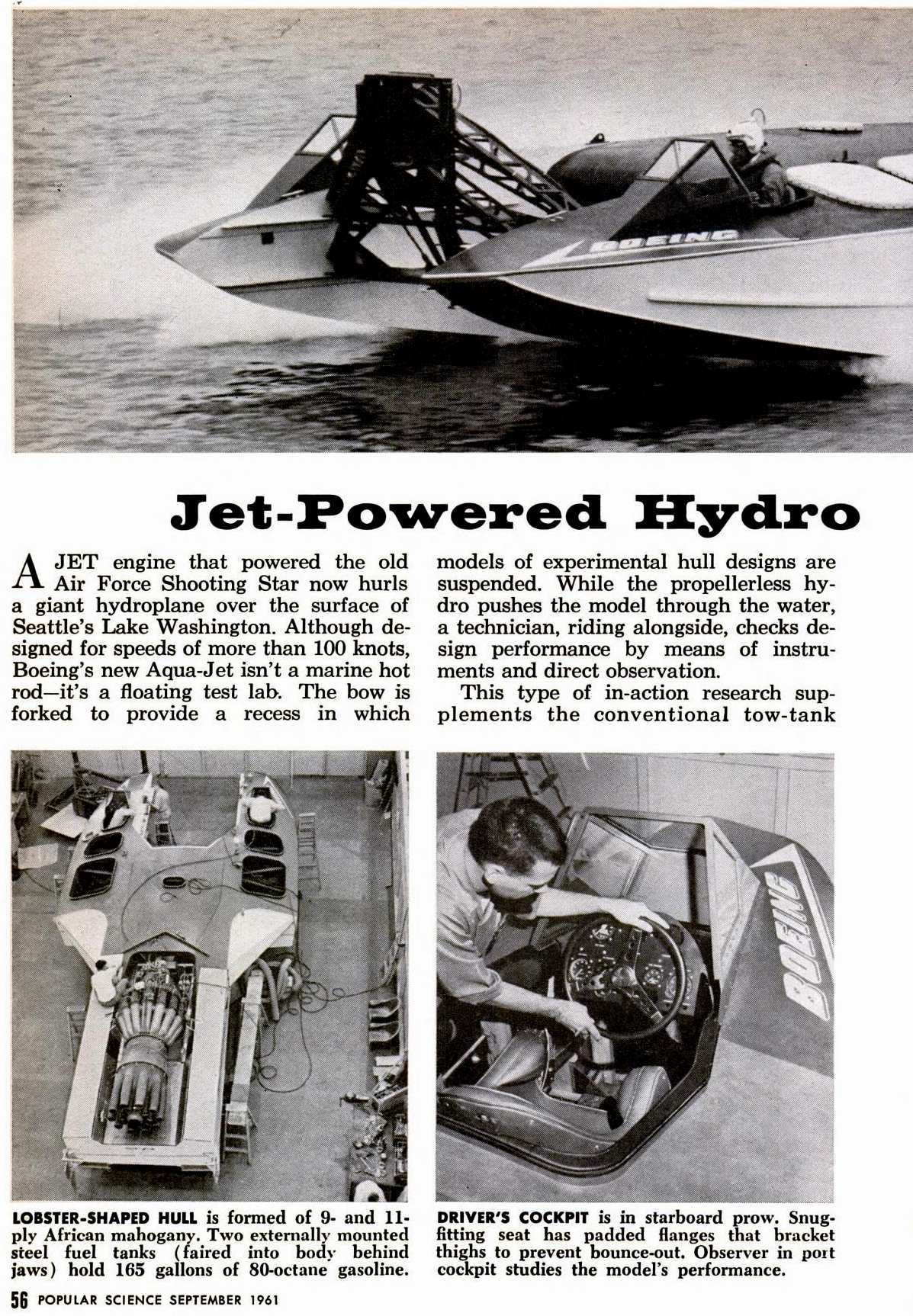
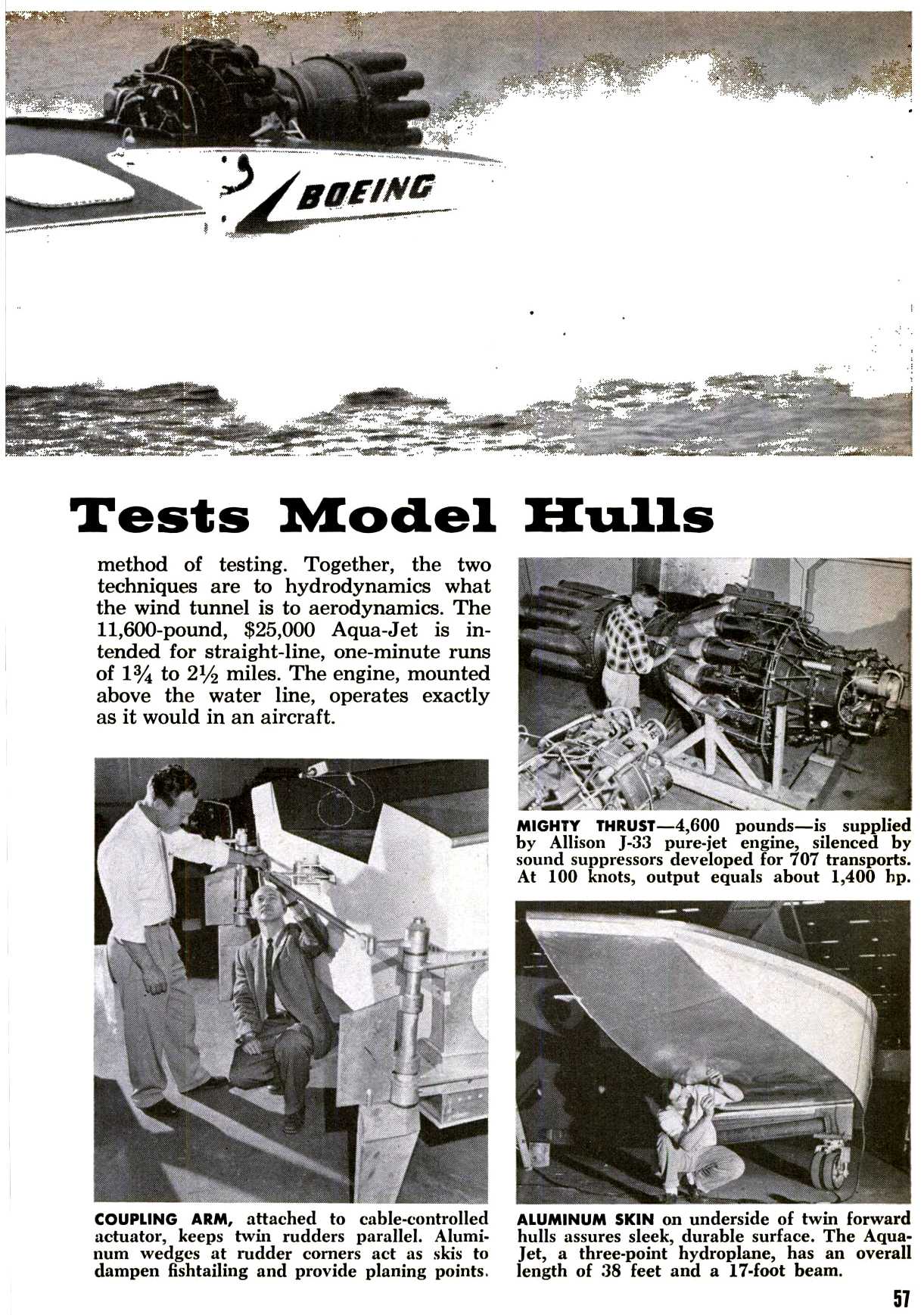
POPULAR
SCIENCE MAGAZINE - These are pages 56 and 57 of the September 1961
edition of this well read publication.
THE
RACING CAMPBELLS
Compared
to the K3 and K4 boats of Sir Malcolm Campbell, the Boeing AquaJet is
scaled up development that like the K7, uses as gas turbine jet
engine instead of conventional propellers
for propulsion.
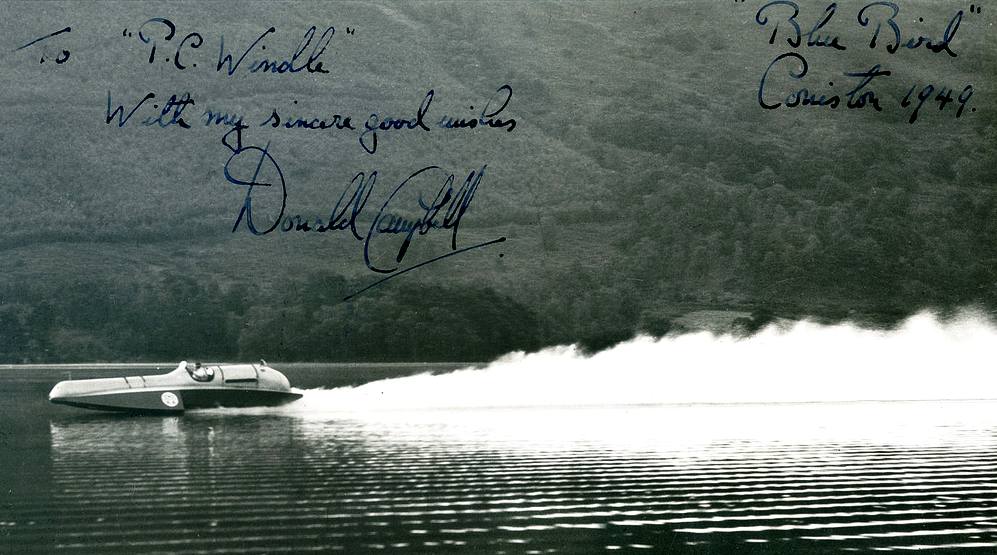
D ONALD
CAMPBELL'S -
Bluebird K4 at speed on
Lake Coniston - autographed photograph inscribed: To PC Windle in 1949.
Both the K3 and K4 had drives going forward to a transfer box, that then
had a prop-shaft going aft. The objective of such transmission was to
get the propeller shaft as horizontal as possible to give thrust in the opposite
direction to the travel of the boat,
as near as possible to 180 degrees, which also tends to counter the
upthrust at the rear that tends to try and rotate the boat into a nose
dive situation.
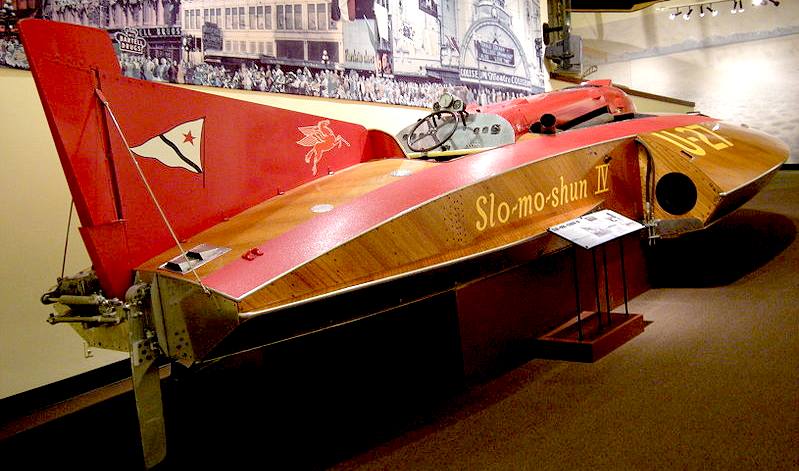
The
Slo-mo-shun water speed record boat - surface piercing prop rider. This is
the boat that inspired so many wooden hydroplanes. The Hydroplane & Raceboat Museum,
5917 South 196th Street - Kent, WA 98032. Phone: 206.764.9453 - FAX: 206.766.9620
Slo-Mo-Shun rides so high that only one of the blades of its special $500 two-bladed propeller is in the water at a time.
LINKS
& REFERENCE
http://slomoshunhydros.com/
http://en.wikipedia.org/wiki/Stanley_Sayres
http://en.wikipedia.org/wiki/Ted_Jones_%28hydroplanes%29
|










